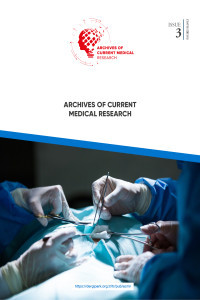Comparison of Lateral Pinning and Cross Pinning Results in Pediatric Distal Humerus Supracondylar Gartland Type 3 Fractures
Comparison of Lateral Pinning and Cross Pinning Results in Pediatric Distal Humerus Supracondylar Gartland Type 3 Fractures
___
- 1. Kwiatkowska M, Dhinsa BS, Mahapatra AN. Does the surgery time affect the final outcome of type III supracondylar humeral fractures? J Clin Orthop Trauma. 2018;9(Suppl 1):S112–5.
- 2. Mallo G, Stanat SJC, Gaffney J. Use of the gartland classification system for treatment of pediatric supracondylar humerus fractures. Orthopedics. 2010;33(1):19.
- 3. Vaquero-Picado A, González-Morán G, Moraleda L. Management of supracondylar fractures of the humerus in children. EFORT Open Rev. 2018;3(10):526-540.
- 4. Omid R, Choi PD, Skaggs DL. Supracondylar humeral fractures in children. J Bone Joint Surg Am. 2008;90(5):1121-32.
- 5. Abbott MD, Buchler L, Loder RT, Caltoum CB. Gartland type III supracondylar humerus fractures: outcome and complications as related to operative timing and pin configuration. J Child Orthop. 2014;8(6):473–7.
- 6. Mostafavi HR, Spero C. Crossed pin fixation of displaced supracondylar humerus fractures in children. Clin Orthop Relat Res. 2000;(376):56-61.
- 7. Lee YH, Lee SK, Kim BS, Chung MS, Baek GH, Gong HS, et al. Three lateral divergent or parallel pin fixations for the treatment of displaced supracondylar humerus fractures in children. J Pediatr Orthop. 2008;28(4):417–22.
- 8. Otsuka NY, Kasser JR. Supracondylar Fractures of the Humerus in Children. J Am Acad Orthop Surg. 1997;5(1):19–26.
- 9. Lyons JP, Ashley E, Hoffer MM. Ulnar nerve palsies after percutaneous cross-pinning of supracondylar fractures in children’s elbows. J Pediatr Orthop. 1998;18(1):43–5.
- 10. Blanco JS. Ulnar nerve palsies after percutaneous cross-pinning of supracondylar fractures in children’s elbows. J Pediatr Orthop. 1998;18(6):824.
- 11. Na Y, Bai R, Zhao Z, Han C, Kong L, Ren Y, et al. Comparison of lateral entry with crossed entry pinning for pediatric supracondylar humeral fractures: A meta-analysis. J Orthop Surg Res. 2018;13(1).
- 12. Larson L, Firoozbakhsh K, Passarelli R, Bosch P. Biomechanical analysis of pinning techniques for pediatric supracondylar humerus fractures. J Pediatr Orthop. 2006;26(5):573–8.
- 13. Lee SS, Mahar AT, Miesen D, Newton PO. Displaced pediatric supracondylar humerus fractures: Biomechanical analysis of percutaneous pinning techniques. J Pediatr Orthop. 2002;22(4):440–3.
- 14. Slobogean BL, Jackman H, Tennant S, Z Gerard PS, Mulpuri K. Iatrogenic ulnar nerve injury after the surgical treatment of displaced supracondylar fractures of the humerus: Number needed to harm, a systematic review. J Pediatr Orthop. 2010;30(5):430–6.
- 15. Garra G, Singer AJ, Taira BR, Chohan J, Cardoz H, Chisena E, et al. Validation of the Wong-Baker FACES pain rating scale in pediatric emergency department patients. Acad Emerg Med. 2010;17(1):50–4.
- 16. Flynn JC, Matthews JG, Benoit RL. Blind pinning of displaced supracondylar fractures of the humerus in children. Sixteen years’ experience with long-term follow-up. J Bone Joint Surg Am. 1974;56(2):263-72.
- 17. Kang S, Kam M, Miraj F, Park SS. The prognostic value of the fracture level in the treatment of Gartland type III supracondylar humeral fracture in children. Bone Joint J. 2015;97-B(1):134-40.
- 18. Boyd DW, Aronson DD. Supracondylar fractures of the humerus: A prospective study of percutaneous pinning. J Pediatr Orthop. 1992;12(6):789–94.
- 19. Zionts LE, Woodson CJ, Manjra N, Zalavras C. Time of return of elbow motion after percutaneous pinning of pediatric supracondylar humerus fractures. Clin Orthop Relat Res. 2009;467(8):2007–10.
- 20. Kumar V, Singh A. Fracture supracondylar humerus: A review. J Clin Diagnostic Res. 2016;10(12):1–6.
- 21. Hamdi A, Poitras P, Louati H, Dagenais S, Masquijo JJ, Kontio K. Biomechanical analysis of lateral pin placements for pediatric supracondylar humerus fractures. J Pediatr Orthop. 2010;30(2):135–9.
- 22. Swenson AL. The treatment of supracondylar fractures of the humerus by Kirschner-wire transfixion. J Bone Joint Surg Am. 1948;30(4):993–7.
- 23. Brown IC, Zinar DM. Traumatic and iatrogenic neurological complications after supracondylar humerus fractures in children. J Pediatr Orthop. 1995;15(4):440–3.
- 24. Royce RO, Dutkowsky JP, Kasser JR, Rand FR. Neurologic complications after k-wire fixation of supracondylar humerus fractures in children. J Pediatr Orthop. 1991;11(2):191–4.
- 25. Skaggs DL, Hale JM, Bassett J, Kaminsky C, Kay RM, Tolo VT. Operative treatment of supracondylar fractures of the humerus in children. The consequences of pin placement. J Bone Joint Surg Am. 2001;83(5):735-40.
- 26. Kwak-Lee J, Kim R, Ebramzadeh E, Silva M. Is medial pin use safe for treating pediatric supracondylar humerus fractures? J Orthop Trauma. 2014;28(4):216–21.
- 27. Maity A, Saha D, Roy DS. A prospective randomised, controlled clinical trial comparing medial and lateral entry pinning with lateral entry pinning for percutaneous fixation of displaced extension type supracondylar fractures of the humerus in children. J Orthop Surg Res. 2012;7(1).
- Yayın Aralığı: Yılda 3 Sayı
- Başlangıç: 2020
- Yayıncı: 14 Mart Tıbbiyeliler Derneği
Gökhan AYTEKİN, Fatih ÇÖLKESEN, Eray YILDIZ, Şevket ARSLAN, Ahmet ÇALIŞKANER
Ahmet KARAYİĞİT, Hayrettin DİZEN, Ümit ÖZDEMİR, Dursun Burak ÖZDEMİR, İhsan Burak KARAKAYA, İlter OZER, Bülent ÜNAL, Murat ULAŞ
Muhammet Salih AYAS, Kerim ÖNER
Emergency major surgery in thoracic trauma: Timing and decision process
Eray ÇINAR, Kubilay İNAN, Ozgur Omer YİLDİZ
Abduction Orthosis in Treatment of Primary Acetabular Dysplasia: Results of Three Years Follow-up
Sinan YÜKSEL, Serhan ÜNLÜ, Onder ERSAN, Faruk CATMA, Yenel Gurkan BİLGETEKİN, Kürşat Reşat DEMİR
Depression, Occupational Anxiety, and Related Factors in Medical Students
Ideal Surgery Time in COVID-19 Process: A Case Report of Pulmonary Hydatid Cyst in Covid Patient
Analyzing Electrocardiography Abnormalities in COVID-19 Patients Admitting to Emergency Department
Miray TÜMER, Ahmet Burak ERDEM, Hakan OĞUZTÜRK, Selahattin GÜRÜ, Gulhan KURTOGLU CELİK, Afşin Emre KAYIPMAZ
Outcomes of Consultations to Burn Units from Emergency Service
